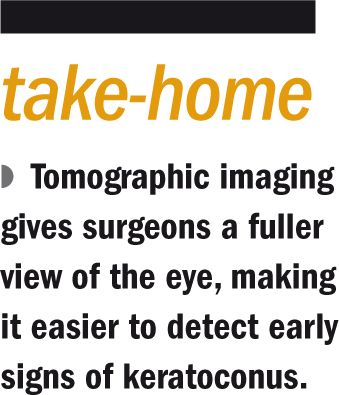Article
Use of tomographic imaging can help detect keratoconus earlier
Tomographic imaging gives surgeons a fuller view of the eye, making it easier to detect early signs of keratoconus.
By Vanessa Caceres; Reviewed by Michael W. Belin, MD
Tomographic methods to detect keratoconus can give eye surgeons a strategic advantage, said Michael W. Belin, MD, professor of ophthalmology and vision science, University of Arizona Health Sciences, Tucson.

Dr. Belin contrasted the older use of Placido-based technology and said that many surgeons likely persist in using it because there is comfort in familiarity.
However, “it’s time to abandon that ship,” Dr. Belin said. “No matter what improvements are made, you are still using an outdated technology.”
Dr. Belin said that older imaging devices all have certain disadvantages-for instance, they are limited to the anterior surface, and they do not consider the negative power contributed by the posterior surface.
“If you don’t measure both anterior and posterior, you can’t general a full corneal thickness map,” he said.
Tomographic analysis can assist surgeons for keratoconus detection, post-IOL computations, the need for toric IOLs, and for crosslinking.
Within the realm of refractive screening, tomographic analysis can help identify susceptible individuals who may otherwise be missed. This is especially important for subclinical keratoconus, in which a patient has an abnormal posterior cornea surface and/or pachymetric progression but still has a normal anterior surface.
“Based on Placido alone, these patients look normal, but they do have true disease,” he said.
Subclinical or suspect
Subclinical keratoconus should not be confused with suspect keratoconus, Dr. Belin cautioned.
With subclinical, there is true disease present.
Placido technology and its single apical readings also lack sensitivity and convey limited information, Dr. Belin said.

In contrast, a full corneal thickness map that is generated by tomography provides information on both the anterior and posterior surfaces. Dr. Belin also highlighted an example of how tomographic technology can better identify pathologic keratoconus.
Similarly, newer imaging techniques can help prevent disease versus treating with corneal crosslinking after a patient has already lost vision, Dr. Belin said.
“We should identify individuals as early as possible and treat if they are progressive,” he said.
The earlier stages of keratoconus appear on the posterior surface or in pachymetric progression. These are prior to visual loss and prior to changes on the anterior surface. That is when to intervene, he noted.
However, this does not always happen, Dr. Belin added.
Dr. Belin shared an ABCD Progression Display that can show up to eight exams over time. Use of this technology can help identify keratoconus development, he said.
Michael W. Belin, MD
e: mwbelin@aol.com
This article was adapted from Dr. Belin’s presentation during Cornea Subspecialty Day at the 2017 meeting of the American Academy of Ophthalmology. Dr. Belin is a consultant for Avedro and Oculus.
Newsletter
Don’t miss out—get Ophthalmology Times updates on the latest clinical advancements and expert interviews, straight to your inbox.




